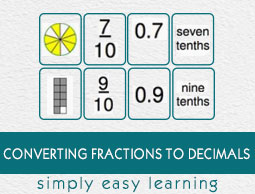
- Converting Fractions to Decimals
- Home
- Writing a Decimal and a Fraction for a Shaded Region
- Converting a Fraction With a Denominator of 10 or 100 to a Decimal
- Converting a Fraction With a Denominator of 100 or 1000 to a Decimal
- Converting a Proper Fraction With a Denominator of 2, 4, or 5 to a Decimal
- Converting a Mixed Number With a Denominator of 2, 4, or 5 to a Decimal
- Converting a Fraction to a Terminating Decimal - Basic
- Converting a Fraction to a Terminating Decimal - Advanced
- Converting a Fraction to a Repeating Decimal - Basic
- Converting a Fraction to a Repeating Decimal - Advanced
- Using a Calculator to Convert a Fraction to a Rounded Decimal
- Converting a Mixed Number to a Terminating Decimal - Basic
- Converting a Mixed Number to a Terminating Decimal - Advanced
- Ordering Fractions and Decimals
Converting a Fraction With a Denominator of 100 or 1000 to a Decimal
Introduction
We should recall decimal place value charts here. We know that, to the right of a decimal point, the places values are the tenths, hundredths, thousandths and so on.
In this lesson, we are considering fractions with denominators of 100 or 1000.
Rules to convert a fraction with a denominator of 100 to a decimal
Let us consider a fraction $\frac{59}{100}$.
At first, we write the numerator 59 only.
As we were dividing with a 100, we are looking at a place value of a hundredth. The digit 9 has a place value of a hundredth. So, a decimal point is put before 5 and we get $\frac{59}{100} = .59$ or $0.59$
Alternately, as the number of zeros in a 100 is 2, the decimal point shifts two places to the left in 59 to make it 0.59
Rules to convert a fraction with a denominator of 1000 to a decimal
Let us consider a fraction $\frac{865}{100}$.
At first, we write the numerator 865 only.
As we are dividing by 1000, we are looking at a place value of a thousandth. The digit 5 has a place value of a thousandth. So, a decimal point is put before 8 and we get $\frac{865}{1000} = .865$ or $0.865$
Alternately, as the number of zeros in 1000 is 3, the decimal point shifts three places to the left in 865 to make it 0.865
Example 1
Write $\frac{36}{100}$ as a decimal.
Solution
Step 1:
At first, we write the numerator 36 as 36.0
Step 2:
Since the denominator 100 has two zeros, we shift the decimal point in 36.0 two places to the left, and get .36 or 0.36 as the answer.
Step 3:
So, $\frac{36}{100} = 0.36$
Example 2
Write $\frac{237}{1000}$ as a decimal.
Solution
Step 1:
At first, we write the numerator 237 as 237.0
Step 2:
Since the denominator 1000 has three zeros, we shift the decimal point in 237.0 three places to the left, and get .237 or 0.237 as the answer.
Step 3:
So, $\frac{237}{1000} = 0.237$